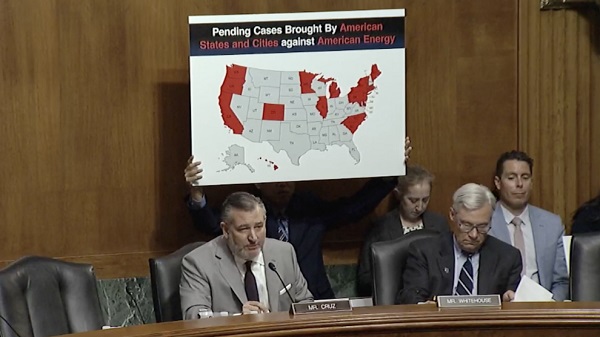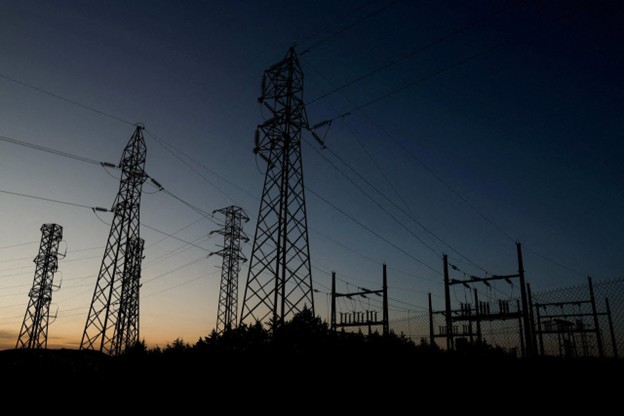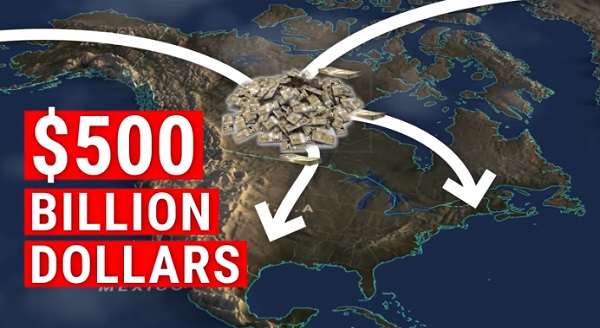Alberta
Lesson for Ottawa—don’t bite the hand that feeds you

From the Fraser Institute
By Tegan Hill
The Alberta government has launched a campaign to inform Canadians about the negative impacts of the federal government’s cap on greenhouse gas (GHG) emissions in the oil and gas sector, which exempts the other three-quarters of the economy that emit including transportation, buildings and heavy industry.
According to Alberta Premier Danielle Smith, the cap will “kill jobs” and lead to “economic and societal decline” for all Canadians—and she’s right. Any policy that damages Alberta’s economy comes with consequences for all of Canada.
Of course, this isn’t the first Trudeau policy to damage the sector. The list includes Bill C-69 (which imposes complex, uncertain and onerous review requirements on major energy projects), Bill C-48, (which bans large oil tankers off British Columbia’s northern coast and limits access to Asian markets), “clean fuel standard” regulations, numerous “net-zero” targets, and so on.
Again, while these policies disproportionately impact Albertans, they have consequences for all Canadians from coast to coast because of Alberta’s role in the federation. In our current system, Ottawa collects various taxes from Canadians across the country and then redistributes the money for programs including equalization and employment insurance.
For perspective, from 2007 to 2022 (the latest period of available data), Albertans contributed $244.6 billion more in taxes and other payments to the federal government than they received in federal spending—more than five times as much as British Columbians or Ontarians. The remaining seven provinces received more federal spending than they contributed to federal revenues. In other words, Albertans are by far the largest net contributor to Ottawa’s coffers.
Albertans’ large net contribution reflects the province’s comparatively young population (fewer retirees), higher rates of employment, higher average incomes and relatively strong economy.
Alberta’s relative economic strength isn’t new. From 1981 to 2022, the province had the highest annual average economic growth rate in Canada. In 2022, Alberta accounted for 17.9 per cent of Canada’s total economic growth despite being home to just 11.6 per cent of the country’s population. That same year, Alberta contributed nearly one in every five private-sector jobs created in Canada. In fact, Alberta was one of only two provinces (alongside Nova Scotia) where private-sector employment growth (including self-employment) exceeded government-sector employment growth over the last five years (2019 to 2023).
Alberta’s prosperity, which helps finance other provinces, may help explain why 56,245 more Canadian residents moved to Alberta than left it in 2022—a much higher net inflow than in any other province. For decades, Alberta has provided economic opportunities for Canadians from other provinces willing to relocate.
Albertans continue to contribute more to the federation than Canadians in other provinces due to Alberta’s relatively strong and prosperous economy. And Canadians benefit from the economic opportunities Alberta provides. With this in mind, the Trudeau government should stop imposing economically damaging policies on the province—as it costs not just Albertans but all Canadians.
Author:
Alberta
Alberta judge sides with LGBT activists, allows ‘gender transitions’ for kids to continue

From LifeSiteNews
‘I think the court was in error,’ Alberta Premier Danielle Smith has said. ‘There will be irreparable harm to children who get sterilized.’
LGBT activists have won an injunction that prevents the Alberta government from restricting “gender transitions” for children.
On June 27, Alberta King’s Court Justice Allison Kuntz granted a temporary injunction against legislation that prohibited minors under the age of 16 from undergoing irreversible sex-change surgeries or taking puberty blockers.
“The evidence shows that singling out health care for gender diverse youth and making it subject to government control will cause irreparable harm to gender diverse youth by reinforcing the discrimination and prejudice that they are already subjected to,” Kuntz claimed in her judgment.
Kuntz further said that the legislation poses serious Charter issues which need to be worked through in court before the legislation could be enforced. Court dates for the arguments have yet to be set.
READ: Support for traditional family values surges in Alberta
Alberta’s new legislation, which was passed in December, amends the Health Act to “prohibit regulated health professionals from performing sex reassignment surgeries on minors.”
The legislation would also ban the “use of puberty blockers and hormone therapies for the treatment of gender dysphoria or gender incongruence” to kids 15 years of age and under “except for those who have already commenced treatment and would allow for minors aged 16 and 17 to choose to commence puberty blockers and hormone therapies for gender reassignment and affirmation purposes with parental, physician and psychologist approval.”
Just days after the legislation was passed, an LGBT activist group called Egale Canada, along with many other LGBT organizations, filed an injunction to block the bill.
In her ruling, Kuntz argued that Alberta’s legislation “will signal that there is something wrong with or suspect about having a gender identity that is different than the sex you were assigned at birth.”
She further claimed that preventing minors from making life-altering decisions could inflict emotional damage.
However, the province of Alberta argued that these damages are speculative and the process of gender-transitioning children is not supported by scientific evidence.
“I think the court was in error,” Alberta Premier Danielle Smith said on her Saturday radio show. “That’s part of the reason why we’re taking it to court. The court had said there will be irreparable harm if the law goes ahead. I feel the reverse. I feel there will be irreparable harm to children who get sterilized at the age of 10 years old – and so we want those kids to have their day in court.”
READ: Canadian doctors claim ‘Charter right’ to mutilate gender-confused children in Alberta
Overwhelming evidence shows that persons who undergo so-called “gender transitioning” procedures are more likely to commit suicide than those who are not given such irreversible surgeries. In addition to catering to a false reality that one’s sex can be changed, trans surgeries and drugs have been linked to permanent physical and psychological damage, including cardiovascular diseases, loss of bone density, cancer, strokes and blood clots, and infertility.
Meanwhile, a recent study on the side effects of “sex change” surgeries discovered that 81 percent of those who have undergone them in the past five years reported experiencing pain simply from normal movements in the weeks and months that followed, among many other negative side effects.
Alberta
Alberta Independence Seekers Take First Step: Citizen Initiative Application Approved, Notice of Initiative Petition Issued

Alberta’s Chief Electoral Officer, Gordon McClure, has issued a Notice of Initiative Petition.
This confirms a Citizen Initiative application has been received and the Chief Electoral Officer has determined the requirements of section 2(3) of the Citizen Initiative Act have been met.
Approved Initiative Petition Information
The approved citizen initiative application is for a policy proposal with the following proposed question:
Do you agree that Alberta should remain in Canada?
The Notice of Initiative Petition, application, and statement provided by the proponent are available on Elections Alberta’s website on the Current Initiatives Petition page.
As the application was received and approved prior to coming into force of Bill 54: Election Statutes Amendment Act, the Citizen Initiative process will follow requirements set out in the Citizen Initiative Act as of June 30, 2025.
Next Steps
- The proponent must appoint a chief financial officer within 30 days (by July 30, 2025).
- Once the 30-day publication period is complete and a chief financial officer has been appointed, Elections Alberta will:
- issue the citizen initiative petition,
- publish a notice on the Current Initiatives Petition page of our website indicating the petition has been issued, specifying the signing period dates, and the number of signatures required for a successful petition, and
- issue the citizen initiative petition signature sheets and witness affidavits. Signatures collected on other forms will not be accepted.
More information on the process, the status of the citizen initiative petition, financing rules, third party advertising rules, and frequently asked questions may be found on the Elections Alberta website.
Elections Alberta is an independent, non-partisan office of the Legislative Assembly of Alberta responsible for administering provincial elections, by-elections, and referendums.
-

 Brownstone Institute2 days ago
Brownstone Institute2 days agoFDA Exposed: Hundreds of Drugs Approved without Proof They Work
-

 Energy1 day ago
Energy1 day agoChina undermining American energy independence, report says
-

 Automotive1 day ago
Automotive1 day agoElectric vehicle sales are falling hard in BC, and it is time to recognize reality.
-

 Business1 day ago
Business1 day agoEurope backs off greenwashing rules — Canada should take note
-

 Automotive1 day ago
Automotive1 day agoPower Struggle: Electric vehicles and reality
-

 Business1 day ago
Business1 day agoTrump on Canada tariff deadline: ‘We can do whatever we want’
-

 Business7 hours ago
Business7 hours agoCanada Caves: Carney ditches digital services tax after criticism from Trump
-

 Crime7 hours ago
Crime7 hours agoSuspected ambush leaves two firefighters dead in Idaho







